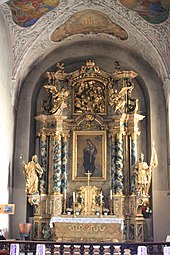Marienkirche (Klagenfurt am Wörthersee)
The Roman Catholic Marienkirche in Klagenfurt am Wörthersee on Benediktinerplatz was consecrated in 1624 and belongs to the Franciscan monastery, which was built at the same time and was later looked after by the Benedictines. The adjacent square is named after them, Benediktinerplatz, the church formerly Benediktinerkirche.
history
Today's St. Mary's Church was founded in 1613 by the Catholic Carinthian provinces with the adjoining Franciscan monastery. The consecration of the monastery took place in 1617. The church was designed by Adam Kolnig and Johann Baptist Klöpfer and was consecrated in 1624. The church was badly damaged in a fire in 1636 and the high altar was destroyed. The interior furnishings survived the great city fire of 1723 undamaged. In 1638 the tower was rebuilt, in 1723 it was raised and provided with an onion helmet and lantern. In 1650/51 the Antonius chapel, donated by Johann Georg Rosenberg, was added to the north side of the choir. The monastery was expanded in 1672 and 1713.
The church was a Franciscan church from 1613 to 1806. From 1807 to 1903 it served as a Benedictine church as the Klagenfurt branch of the Benedictines residing in St. Paul Abbey in Lavanttal . The change in the patronage goes back to the Benedictines. From 1909 to 1986 the Marienkirche was looked after by the Jesuits. The current rector of St. Mary's Church is Pavo Dominkovic, OFM .
Building description
The church is a single-nave, baroque building, has an unadorned exterior and is attached to the north side of the monastery complex. The choir has just ended. The Antonius Chapel has a round apse . The octagonal tower with a copper onion helmet and lantern is located between the nave and the choir. The windows of the church are arched. The north side faces Benediktinerplatz with four windows, the Antonius Chapel protrudes into the square.
The nave has a barrel vault with stitch caps, which rests on stone consoles; the cross ridges are colored. On the triumphal arch wall there are three baroque paintings that were renewed by August Veiter around 1900: they show the Emmaus meal and the hll. Peter and Paul. The pictures are surrounded by heavy stucco by Johann Peter Wittini from the end of the 17th century. Similar stucco is in the cross vault of the choir, where there is a painting of the church fathers . In the vault of the Antonius Chapel, a glorification of St. Anthony by Johann Kolb (1851) can be seen, with angels floating in the apse. Around the chapel portals there is stucco from around 1640, making it the oldest stucco preserved in Klagenfurt. The stucco is characterized by pearl rods, palmettes, rosettes and winged putti heads. To the west of the church is the three-axis, barrel-vaulted organ gallery, which rests on Tuscan columns. It curves against the nave and has arched openings.
Facility
The high altar used to be in the Antonius Chapel and dates from 1747. It has smooth and twisted columns, the altarpiece shows the Mother of God with the child and is a reverse copy of an engraving by Albrecht Dürer . The picture has been in the church since 1706. The side figures of the altar are the hll. Antonius Eremita and Florian . The upper floor of the altar contains a carved relief of the vision of St. John on Patmos.
The two side altars from 1738/39 are similar, they are made of stucco marble. The left altar panel shows the Holy Family and comes from Ida Culoz (1843), the top a picture of God the Father. There is a picture of St. Ignatius on the cafeteria . The right side altar has a crucifixion by Josef Ferdinand Fromiller , the top picture shows the resurrection of Christ, on the cafeteria there is a miraculous image of Maria Genazzano (1761).
The classicistic high altar of the Antonius Chapel and the tabernacle are by Josef Stauder (1851). The altarpiece of St. Anthony was made by August Veiter (around 1900). The two figures of St. Benedict and St. Francis come from Franz Xaver Renn from Imst . The Pietà by Alois Winkler is from around 1900. In the choir there are pictures of hll. Johannes Nepomuk , Benedikt and Anna with child.
The pulpit (around 1760) bears prophets seated on the parapet in white poliment , the sound cover bears the Franciscan saint Johannes Capistran and personifications of the three virtues , faith, hope and love. The organ case dates from 1777.
A large number of gravestones and memorial stones provide an overview of the upscale society immediately after the Counter-Reformation . The Stations of the Cross are probably from Fromiller’s school. A Romanesque standing cross that was previously set up in the church is in the Diocesan Museum.
supporting documents
- Siegfried Hartwagner: Klagenfurt City (= Austrian Art Monograph , Volume X). Verlag St. Peter, Salzburg, pp. 71-79. (Reprinted in 1994, without ISBN)
- Dehio Handbook Carinthia . 3rd edition, Anton Schroll, Vienna 2001, p. 362f. ISBN 3-7031-0712-X
Individual evidence
- ↑ Website of the Jesuits ( Memento of the original of July 27, 2007 in the Internet Archive ) Info: The archive link has been inserted automatically and has not yet been checked. Please check the original and archive link according to the instructions and then remove this notice. , accessed March 14, 2009.
- ↑ Website of the Diocese of Gurk ( Memento of the original from January 9, 2006 in the Internet Archive ) Info: The archive link was automatically inserted and not yet checked. Please check the original and archive link according to the instructions and then remove this notice. , accessed March 14, 2009.
Coordinates: 46 ° 37 ′ 20.6 ″ N , 14 ° 18 ′ 22.6 ″ E





